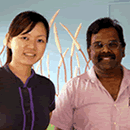Why Singapore’s English Teachers Should Embrace Singlish, Not Fight It
Is it time for Singaporean educators to embrace Singlish as a legitimate learning tool? What the Research […]
Read More
Compassvale Secondary School teachers evaluate their new Integrated Curriculum through action research
 If schools had a “report card”, this is what it might say for Compassvale Secondary:
If schools had a “report card”, this is what it might say for Compassvale Secondary:
Many of the teachers in this school are HOT – “Happy Ordinary Teachers”. Not only are they passionate about their work, their commitment to helping students learn has led some of them to become curriculum designers. At the same time, they’re also enthusiastic about conducting action research.
Take Mr Arasumani, for example. If anyone exemplifies this spirit of innovation in the classroom, it would be Mr Arasu. He has been teaching for 26 years, and still he is constantly asking himself how he can do things better.
In 2006, he led the Secondary 2 teachers at Compassvale Secondary in implementing an Integrated Curriculum (IC) programme. The IC programme, as he defines it, aims “to show links between the different subjects”.
In this programme, level teachers work closely together to design “integrated” lessons that were centred around themes. For 2007, teachers chose the theme “People – Singapore’s Most Precious Resource”. This enabled students to see the relationships and connections among different disciplines.
Instead of the usual continual assessments and semestral examinations, students were given various performance tasks which required them to use the knowledge, values and skills of the different subjects together.
“What is most valuable about the Integrated Curriculum is the autonomy that’s given to the teachers to be active curriculum designers,” noted Vice-Principal Mrs Sng Ching Yee. “The synergy which we managed to hone among the teachers through very open dialogue about each other’s curricular priorities, to come together to determine certain key pedagogical practices and assessment formats.”
As this was a new initiative, the teachers could not be certain about its effectiveness in achieving the desired learning outcomes. The next step for them was to initiate a process of careful evaluation – they decided to do some action research (AR).
AR was already a part of the school’s culture. It was first introduced in 2005 by their Principal, Mrs Ang Ju Lang, with help from consultants from NIE. “We embarked on AR because it’s basically a natural progression as we grow as a school,” explained Mrs Sng. “AR is actually one of the ways to build the capacity of our teachers.”
The school is so serious about AR that all of their teachers are involved in doing research. Last year, the school even published a book of their research reports based on AR projects done in 2005 (Chew, 2006). This caught the attention of the Education Minister, who highlighted it in his speech at last year’s Work Plan Seminar as an example of schools that have taken the initiative to deepen their teachers’ expertise through practice-oriented research.
The school is currently putting together a second publication, edited by Dr. Lana Khong from the Policy and Leadership Studies Academic Group at the National Institute of Education.
For Mr Arasu and his colleagues, AR offered a good way to evaluate the effectiveness of their IC programme. Said his colleague and fellow researcher, Ms Bernice Tay, “AR offered a good structure for reviewing the programme – how do we assess, how do we review, how do we analyse our data.”
They carried out surveys and conducted interviews with teachers, students and even parents. They also engaged in an extensive review of the literature. “It’s a very holistic kind of research,” added Bernice.
The team carried out the AR in Semester 2 of 2006 and turned up some surprising finds.
For example, they found that they had inadvertently over-stretched the students. “The students found it enjoyable but very stressful. We found that we gave them too many performance tasks last year within a short period of 15 weeks,” shared Mr Arasu. So this year, they have cut down on the number of performance tasks, focusing more on quality rather than quantity.
They were also surprised to find that the students lacked the skills to do groupwork, which was integral to completing the performance tasks. “We found that there are some students who do not know how to participate, do not know how to hold discussions,” explained Bernice.
But isn’t groupwork something that teachers have always employed? “You see, that was our mistake,” said Mr Arasu. “It was an assumption that kids would know how to do groupwork, but the feedback from the pupils made it clear that they did not know – they got together as a group but they didn’t know how to function as a group. That was a very key learning point for us.”
The findings from their research have helped them improve on the design of this year’s IC programme, which was rolled out when the new school year began.
For this team, the entire process has been a satisfying and rewarding one – to be able to trial a new pedagogical method, and also to be able to say with confidence that this is the way to go, based on the evidence in hand.
“AR really helps us take stock of what we have done – I think that’s very important,” said Mr Arasu. “Without AR, I probably would have done feedback, but I think it’ll be at quite a superficial level. AR really forces us to do in-depth research, thinking, reflection and writing.”
Comparing the end result to finding “gold at the end of the rainbow”, Bernice said, “When we just begin, we do not really see the benefits. But at the end of it we realise it’s actually very beneficial to us.”
Reference
Chew, L. C. (2006). Action research across the curriculum. Singapore: Pearson.